385 Search Results for complex communication
April 16, 2014
by Carole Zangari -
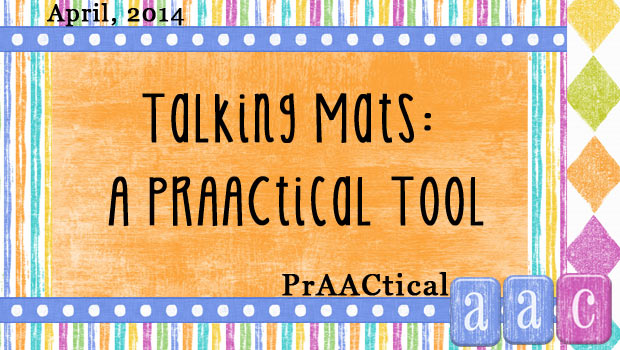
We’ve shared about Talking Mats in a video and on our Facebook page, but we needed to call on the experts to go into more detail about this approach. Thankfully, the co-directors of this project, Dr. Joan Murphy and Lois Cameron, were willing to collaborate. in this post, Dr. Murphy shares her knowledge with us. Hope you enjoy learning about the implementation of Talking Mats as much as we did. What is Talking Mats? Talking Mats is an innovative, award-winning communication tool which is based on extensive research and designed by Speech and Language Therapists in Scotland. Our vision is to improve the lives of people with communication difficulties by increasing their capacity to express their views about things that matter to them. Talking Mats is an interactive resource that uses three sets of picture symbols – top scale, topics and options and a space on which to display them.... [Read More...]
March 31, 2014
by Carole Zangari -
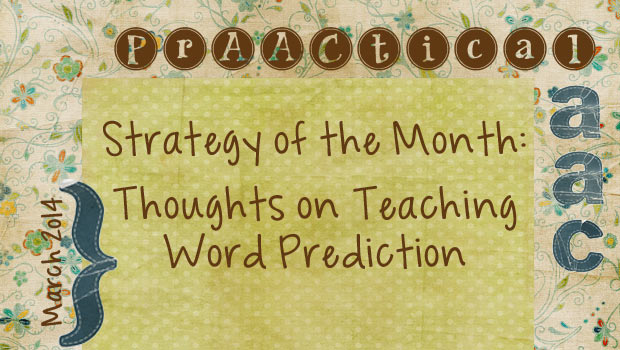
As we wrap up a month of AAC and literacy, let’s look at a strategy that spans communication, reading, and writing. Word prediction, as you know, is a strategy in which the learner begins spelling a word and the AAC device provides a word bank of possible options using a prediction algorithm. There are lots of kinds and levels of prediction, and the technology keeps getting better and better. Word prediction is built into most high tech SGDs, many text-to-speech apps, and some writing programs. In this post we consider some of the issues around using and teaching word prediction. Time and Effort Word prediction (WP) saves keystrokes, which is important for our prAACtical friends who have limited energy, poor endurance, and issues with fatigue. Does it save time? Not always, and there were some important studies that revealed this in the mid-1990’s. Of course, technology has improved a lot... [Read More...]
March 5, 2014
by Carole Zangari -
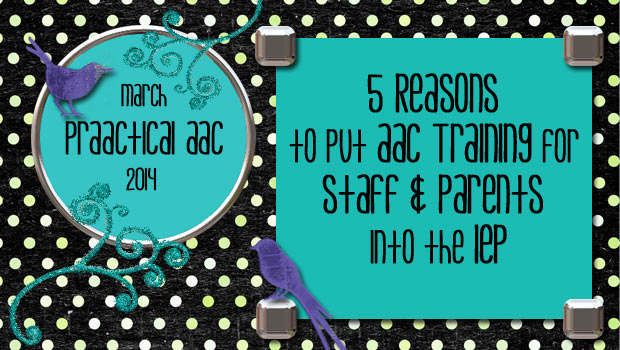
SLPs tend to love (good, relevant) professional development. We flock to conferences (15,000+ ASHA attendees this past November), sign up for workshops, and attend webinars. But for some reason, we are reluctant to request training as part of the IEP process, even when we’re not very confident in our work with the student. Maybe we don’t want to acknowledge our need for it, or admit that there is something we don’t know (gasp!). Perhaps we’d just rather not make waves. We may ask for training informally, but it doesn’t always get tied to specific students’ IEPs, and that may mean that our requests get overlooked. Here are a few reasons why you may want to put staff training into IEPs when needed. We need it. The complexity of the AAC field, diversity of this clinical population, and the rapid pace of change in technology make it very unlikely that any... [Read More...]
March 3, 2014
by Carole Zangari -

We get so many questions about the best way to ‘do’ literacy with AAC learners that decided to build on the earlier posts from and talk more about the ways in which we can support the development of reading and writing skills. For AAC learners, the most important skill set (after communication) is the ability to read and write. When given the chance, we’d teach literacy before almost anything else. Why? First, because it opens the door to so many things. When someone can read and write they are more likely to be successful with academics, find jobs and develop real careers, and enjoy productive leisure time. Secondly, we find that it changes people’s perceptions of an AAC learner. When they see Billy writing or reading with comprehension, they understand that his severely limited speech does not reflect his intellect, motivation, or potential. It shapes their perception of him to... [Read More...]
February 26, 2014
by Carole Zangari -

When we did our graduate training, there was little or no mention of Rett Syndrome, a genetic disorder involving a mutation of the MECP2 (Methyl CpG Binding Protein 2) gene on the long arm of the X chromosome. It is a complex disorder and the abilities of those who are affected by it are generally masked by the motor challenges that are a part of Rett. We’ve asked some professionals experienced in Rett and AAC to help us use this space to help us gain a better understanding of the disorder and its implications for AAC intervention. Sally-Ann Garrett (Highly Specialist Speech and Language Therapist; Reg. HCPC; MRCSLPT, Reg. ASLTIP) is one who agreed to do so and we are grateful for her perspective. Sally-Ann is semi-retired now but has worked with girls affected by Rett Syndrome for 30 of her 42 years as an SLT. She lived in Canada for a number... [Read More...]
February 24, 2014
by Robin Parker -

Positive Reinforcement has a lot of power but it is a lot more than making a learner feel good about themselves. Positive reinforcement is the response to a behavior that will make that behavior occur again. In AAC and teaching terms, we are often thinking about a communicative or language behavior. We can also be thinking about a participation behavior that will allow a learner to have more access to meaningful language experiences. We are not usually thinking about ‘good art’ or ‘great work’. By keeping in mind some top positive reinforcement strategies, you will be prepared to have varied individualized strategies that will make it most likely that the communication behaviors you are teaching will spontaneously occur again and again. Power Positive Reinforcement Strategies for AAC Learners: Natural Positive Reinforcers– It is naturally reinforcing to ask for an item and then be given that item. It is naturally reinforcing... [Read More...]
November 4, 2013
by Robin Parker -

Strategy of the Month Building Participation Building Participation with Older Learners Classroom Participation Community Participation PrAACtical Thinking Second Annual AAC Awareness Month Celebration! 5 Fun AAC Things to do to Get Ready for Halloween 30 Posts You May Have Missed in September Celebrate AAC Awareness Month with PrAACtical Giveaways Another PrAACtical Celebration How Can we Make ‘Clients’ ‘like’ Using their AAC ? 6 Things to Learn from Talking AAC Communicative Competence in AAC Throwback Thursday Core Word Round Up Celebrating AAC Awareness Month 2013 Halloween Recipes for Cooking AAC Style Fast FAACt- What 24 Cents Will Buy Perception & Presuming Competence 5 Ways to Promote Consistent AAC Use What Went Well How I Do It Implementing AIded Language Input with Alicia Garcia 5 AAC Things I Wish I Had Known with Deanne Shoyer Teach Me Tuesdays Alexicom AAC Proloquo2Go Video of the Week Everyone Communicates- Advocacy & Inclusion Developing Communicative Competence... [Read More...]
October 21, 2013
by Robin Parker -

More core word prAACtice ideas. Whether you are just getting started or have been working with core word vocabulary for a long time, the teaching strategies you use to TEACH, helps turn regular words into real communication and language. Provide Aided Language Input- ALI in Meaningful Language Experiences. PrAACtice USING core words in many, many opportunities. Authentic, meaningful prAACtice is fun for everyone. This core word prAACtice is for November. There is a lot of food, leaves, changes of weather, thankfulness, sharing, and holiday spirit. Here are some ideas of activities that can go with the core word words, phrases and sentences: Do art project– Make a turkey because there are many opportunities to use body. From asking for the ‘body of the turkey” and asking for “feathers of the body” there can 50-100 opportunities for prAACtice. You can do this with a beginning communicator who can ask for a... [Read More...]
October 15, 2013
by Robin Parker -
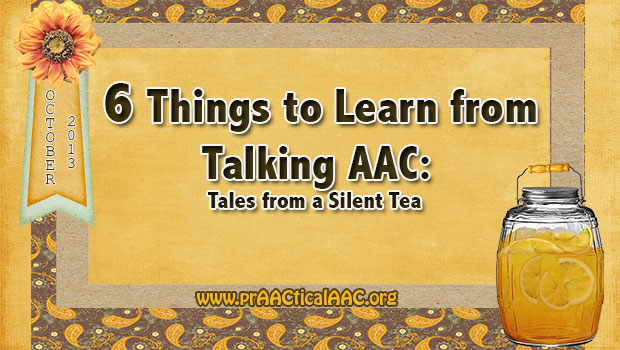
We participated in a silent tea. We used no tech, low tech, and high-tech AAC. For 1 hour. With a group of graduate students, families, and clients. We only communicated with AAC, no natural speech. It was enlightening to say the least. We have done silent teas before, but not recently and as it turns out, a lot was forgotten. Lessons Learned: Communication Takes Longer. Communication takes much longer when using a speech generating device. This is true even when you know the message you are trying to compose, even when you know where the symbols or words are located. We are pretty good at using pause time and waiting expectantly but realized we need to probably wait even longer for messages to be composed. As long as the interaction is continuing, waiting 45 seconds is not too long and if you see someone in... [Read More...]
October 5, 2013
by Carole Zangari -
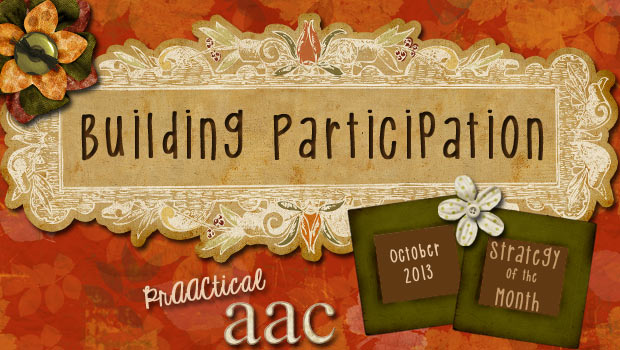
Do you know any of our friends? Jenna can use a talking switch with only a little bit of support. But at calendar time, no one thinks of asking her a question. Hao knows almost two dozen signs and can use a communication wallet with non-signers. But at social gatherings, he’s mostly off to the side playing a game on his iPhone. Isaac uses his SGD capably and can create grammatically correct sentences that include noun phrases and conjunctions. But in Chemistry, his lab group conducts their experiments and writes up the lab report without his contributions. Sienna is able to choose between preferred and non-preferred items in a field of three and is learning to do so in a field of four. But the only time she gets to make a choice is at mealtimes. Like many of you, we put in countless hours helping children and adults who... [Read More...]









